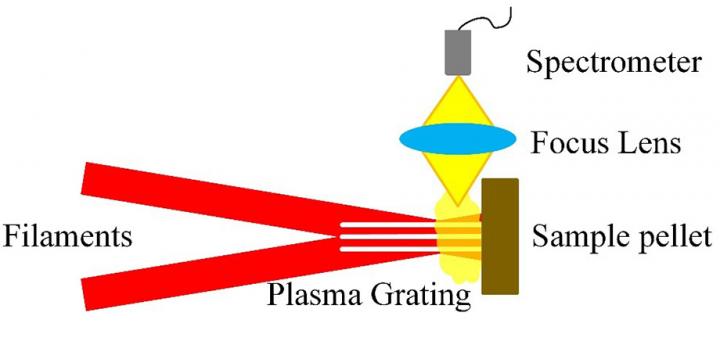Overcoming limitations inherent in other LIBS techniques, plasma-grating-induced breakdown spectroscopy enhances signal intensity by more than three times

Credit: SPIE
Laser-induced breakdown spectroscopy (LIBS) is a rapid chemical analysis tool. A powerful laser pulse is focused on a sample to create a microplasma. The elemental or molecular emission spectra from that microplasma can be used to determine the elemental composition of the sample.
Compared with more traditional technology, like atomic absorption spectroscopy and inductively coupled plasma optical emission spectroscopy (ICP-OES), LIBS has some unique advantages: no sample pretreatment, simultaneous multi-element detection, and real-time noncontact measurements. These advantages make it suitable for practical analysis of solids, gases, and liquids.
Traditional LIBS and extensions
Traditional LIBS systems based on a nanosecond pulse laser (ns-LIBS) have some disadvantages due to laser power intensity, long pulse duration, and the plasma shielding effect. These issues adversely affect its reproducibility and signal-to-noise ratio. Femtosecond LIBS (fs-LIBS) can exclude the plasma shielding effect since the ultrashort pulse duration limits the laser-matter interaction time. The femtosecond pulse has a high power density so materials can be effectively ionized and dissociated, leading to a higher signal-to-background ratio and more precise spectral resolution.
Filament-induced breakdown spectroscopy (FIBS) combines the LIBS technique with a femtosecond laser filament. A single laser filament results from the interplay between the Kerr self-focusing and plasma defocusing mechanisms present in the propagation of an ultrashort, high-intensity beam in a transparent medium such as atmospheric air. The femtosecond laser filament produces a long and stable laser plasma channel, which guarantees the stability of the laser power density and can improve measurement stability. However, the power and electron densities saturate when the laser energy increases. This is known as laser intensity clamping effect, and it limits the detection sensitivity of FIBS.
Plasma grating
Fortunately, the laser intensity clamping effect can be overcome through a plasma grating induced by the nonlinear interaction of multiple femtosecond filaments. The electron density in the plasma grating has been proven to be an order of magnitude higher than that in a filament.
Based on that insight, researchers under the leadership of Heping Zeng at East China Normal University in Shanghai recently demonstrated a novel technique: plasma-grating-induced breakdown spectroscopy (GIBS). GIBS can effectively overcome the drawbacks of ns-LIBS, fs-LIBS, and FIBS. With GIBS, the signal intensity is enhanced more than three times and the lifetime of plasma induced by plasma grating is approximately double of that obtained by FIBS with the same initial pulse. Quantitative analysis is feasible because of the absence of plasma shielding effects, the high power, and the electron density of femtosecond plasma grating.
###
Zeng notes that the GIBS technique could be a promising tool for detecting samples that are hard to melt, ionize, or dissociate, and can also serve for samples with complex matrices.
Read the original research article by M. Hu et al., “Plasma-grating-induced breakdown spectroscopy,” Adv. Photon. 2(6), 065001 (2020), doi 10.1117/1.AP.2.6.065001
Media Contact
Daneet Steffens
[email protected]
Original Source
https:/
Related Journal Article
http://dx.




